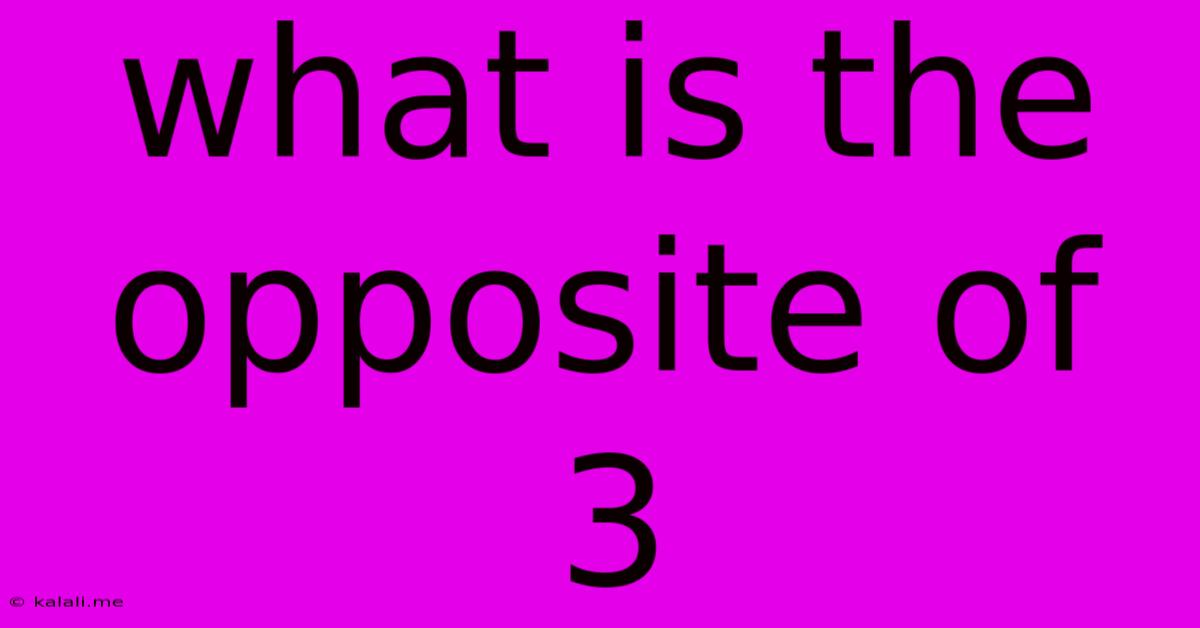What Is The Opposite Of 3
Kalali
May 09, 2025 · 2 min read

Table of Contents
What is the Opposite of 3? A Deep Dive into Opposites in Mathematics
What's the opposite of 3? It's a seemingly simple question, but the answer depends heavily on the context. This article explores the various interpretations of "opposite" in mathematics and how they relate to the number 3. Understanding these nuances is crucial for anyone working with numbers, whether in basic arithmetic or advanced mathematical concepts.
The most common interpretation of "opposite" in relation to a number is its additive inverse. This is the number that, when added to the original number, results in zero. Therefore, the additive inverse of 3 is -3. This is because 3 + (-3) = 0.
Beyond Additive Inverses: Exploring Other Interpretations
While the additive inverse is the most straightforward answer, the concept of "opposite" can be more nuanced. Let's examine other mathematical perspectives:
-
Multiplicative Inverse (Reciprocal): The multiplicative inverse, or reciprocal, of a number is the number that, when multiplied by the original number, results in 1. The reciprocal of 3 is 1/3 or 0.333... (a repeating decimal). This is a different kind of "opposite" than the additive inverse.
-
Geometric Opposites: In a geometric context, especially on a number line, the opposite of 3 would simply be -3, reflecting the number across zero. This visually reinforces the concept of the additive inverse.
-
In the context of sets: the concept of "opposite" doesn't directly apply to the number 3 itself. However, we can consider opposites within set theory through concepts like complements or inverse functions, but these relate to sets and operations on them, not directly to a single number like 3.
Understanding the Importance of Context
The key takeaway here is the importance of context. When someone asks "What is the opposite of 3?", the most likely and correct response is -3, referring to its additive inverse. However, understanding the broader mathematical context allows for a deeper understanding of different interpretations of the term "opposite" and the diverse ways numbers relate to one another. Recognizing the existence of other "opposites," such as the multiplicative inverse, expands your mathematical vocabulary and problem-solving abilities.
Conclusion: The Power of Precision in Mathematics
Mathematical language is precise. Understanding the subtle differences between concepts like additive and multiplicative inverses is fundamental to accurate mathematical communication and problem-solving. While -3 is the most common and straightforward answer to "What is the opposite of 3?", knowing other mathematical interpretations allows for a more robust and complete understanding of numbers and their relationships. Remember to always consider the context when interpreting mathematical terms.
Latest Posts
Latest Posts
-
What Is 60 Of 75 Of 60
May 09, 2025
-
What Is 12 7 Mm In Inches
May 09, 2025
-
29 Cm Is Equal To How Many Inches
May 09, 2025
-
Cuanto Es 88 Grados Fahrenheit En Centigrados
May 09, 2025
-
60 Is 40 Of What Number
May 09, 2025
Related Post
Thank you for visiting our website which covers about What Is The Opposite Of 3 . We hope the information provided has been useful to you. Feel free to contact us if you have any questions or need further assistance. See you next time and don't miss to bookmark.